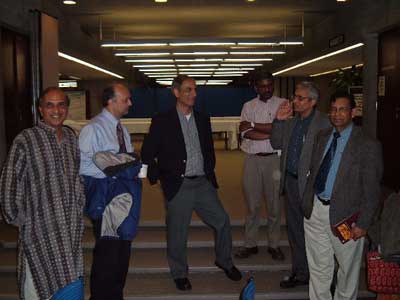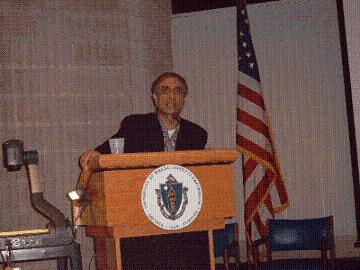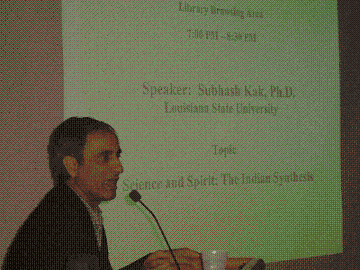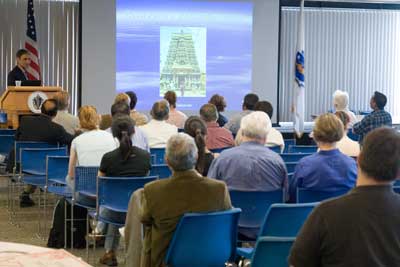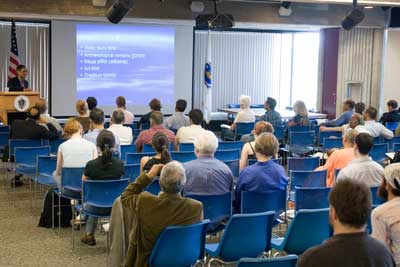Contribute
| Subhash Kak Outlines Integration Of Art, Science And Philosophy At UMass Dartmouth |
Bal Ram Singh
05/16/2006
There are only rare occasions in academia when an engineer talks about art as in paintings and architectural design to extract science behind it, and more importantly connect it a true human spirit and ancient time. This was though exactly what happened the University of Massachusetts Dartmouth when Dr. Subhash Kak, Professor of Electrical and Computer Engineering at Louisiana State University made two presentations under the Patanjali Lecture series organized by the Center for Indic Studies. Both the lectures were presented outlining the integration of art, science and philosophy.
Dr. Subhash Kak, an electrical engineer from Louisiana State University, is a prolific mind in unearthing many of the ancient architectural designs in India to understand the scientific mindset of those times, and consequent philosophical approach to life with the integration of art and science.
In the general lecture entitled “Science and Spirit: The Indian Synthesis†on May 4th evening, Dr. Kak made a moving argument on the status of physical and spiritual sciences within each human being, which are referred to as Apara and Para vidya in Indian philosophical descriptions. The Indian tradition claims to present an overarching science of which the understanding of the physical world and consciousness are components.
He began with the question, “why there is so much unhappiness in today’s society, especially amongst youth groups?†Dr. Kak stated that it is not because they do not have physical resources or even the understanding of the physical world. He suggested that there is knowledge beyond the physical world that is missing in the lives of today’s young people.
This knowledge, known as spiritual experience, as rational as the physical science, and has been part of India’s ancient tradition that can be evaluated in light of modern science. Dr. Kak referred to the interaction between Indian and Greek philosophers, and explained how Greek philosophers only thought of only four elements (Air, Fir, Water, and Earth) while Indian philosophers had included the Ether element to reflect forces beyond perception.
In more modern times, Erwin Schrodinger, known as father of modern physics for his discovery of the Schrodinger wave equation to explain quantum theory of matter, was clearly influenced by Vedanta philosophy. Schrodinger is well known to have read and borrowed the idea of Maya to explain the dual nature of particles.
Dr. Kak offered Yoga and Ayurveda to be well thought out practices based on the spiritual science developed by Indian sages several millennia ago. The West is just beginning to explore that aspect.
“This kind of scientific and philosophical approach will form a stronger and longer lasting interaction between India and the West than what is expected from economic and political interests,†said Dr. Bal Ram Singh, Director, Center for Indic Studies.
In his more academic lecture entitled “Art and Cosmology in India†Dr. Kak addressed the question of the essence of Indian culture through the symbols of its art and architecture. According to Dr. Kak, “the language of art uses the alphabet of the cultural expression to construct representations of reality, and vital art also communicates paradox and oppositions that underlie ordinary experience of the universe.â€
Indian cosmology, which incorporates within it both rational structure as well as paradoxical oppositions, was described to show how it is common to both Indian art and science. The lecture illustrated these points using examples of temple architecture and iconography, and paintings.
Dr. Kak’s lectures were very well received by the faculty as well as students at UMass Dartmouth, and had attracted audience from as far away as Boston and Providence.
Professor Laurie Robertson-Lorant of Education department summed up his lecture as “I would say he is a Renaissance man, but that term seems too restricted and culture-bound to describe an Indian scholar. I especially liked his connection of science and mysticism, and the way he showed how Indian philosophy and science support explorations at and beyond the limits of current knowledge, unknown and inexplicable realities.â€
“Dr. Kak demonstrated to us in his lectures that it is possible to objectively unite science and religion through yogaâ€, stated Kimberly Green, an undergraduate students currently registered in a 3-credit Science of Kriyayoga class being taught at UMass Dartmouth.
As a reminder to the difficulties involved in reaching the unity of world’s events, Dr. Kak cautioned “if extraordinary experience is an epiphany, it comes at the end of a long preparation.â€
He pointe out, “In myth, we speak of the struggle between the asuras (demons) and the devas (gods), but this struggle also occurs within the individual between his materialistic and acquisitive tendencies that are demonic, and those of sacrifice, compassion, and understanding that are divine. This struggle is described as the churning of the ocean by the gods and the demons.â€
One must be first prepared for the churning of ocean before expecting the experience of epiphany.
You may also access this article through our web-site http://www.lokvani.com/
